April 27, 2023
Electric Roadtrip liveblog - Day 1 - Tacoma to Stanton County Park (Canyonville, OR)
Day 1 of my electric roadtrip, I drove from Tacoma, WA to Stanton Park, Canyonville, OR (~350 miles). I like to camp when possible on EV road trips; tent time is good, and I can usually charge overnight at any RV spots.
Packing:
Packing for an electric road trip is more or less the same as for a regular (gas car) roadtrip; there’s just a couple of things that are different, enabled by the big EV battery:
- I carry a power pack (EcoFlow Delta Mini) and a powered cooler; the main EV battery keeps the Delta topped off during the day, the EcoFlow keeps the cooler cool through the night
- I also bring electric camp kitchen devices - an electric Moka pot, an electric kettle. In the mornings, I can run them off of the EcoFlow and not have to get out fuel or my little alcohol stove
Planning and routing:
Planning and routing an EV Roadtrip planning currently requires a hodgepodge of mapping apps and maps; basically, you need to find a destination; a route with chargers spaced well; and a plan for which chargers to use and how long to charge at each one.
Some considerations:
- Electric cars generally charge _much_ faster when their batteries are low than when they’re closer to full; for the Chevy Bolt, it charges at ~50 kW in the 0% - 50% range; and tapers off from there to ‘pretty slow’ in the 80% range
- You don’t need to or want to “fill up” at each charger; you instead want to charge only enough to get to the next charger in your plan, plus some buffer
- Hills and temperature affect range - budget for them!
For the first day, I looked for a campground near Grants Pass, OR; I had a noon meeting, so I couldn’t start that early. Grants Pass is ~380 miles, a good day’s drive.
Once I found an open campground (Stanton Park, in Canyonville, OR), I used ‘A Better Router Planner’ (better than nothing, anyway) to make a route from Tacoma, WA to the campground:
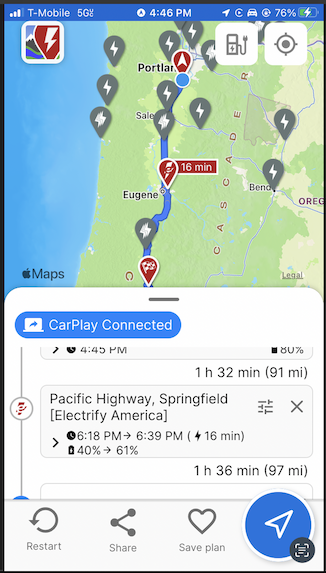
A Better Route Planner created a plan that had me charge for ~30 minutes in Portland, OR and ~30 minutes in Springfield, OR.
Once A Better Route Planner comes up with a plan, I check the first charger on PlugShare, an app that tracks recent checkins to a charger, to make sure that it's working. I then use Google Maps to route to the charger. At each charger, I repeat for the next, while waiting for the car to charge.
On-the-fly Rerouting:
Today was a beautiful, mid-70s, low-wind day; the Bolt was running more efficiently than it has all winter, so I was able to stretch the first leg from Portland, OR to Wilsonville, OR. Wilsonville, OR has one of my favorite chargers - it’s right next to a library and a city park, a great spot to fill up on water and go for a solid walk. And It’s on the Shell Recharge network, which works reliably in my experience.
To re-route, I checked the Wilsonville charger on PlugShare and had Google Maps route there instead:
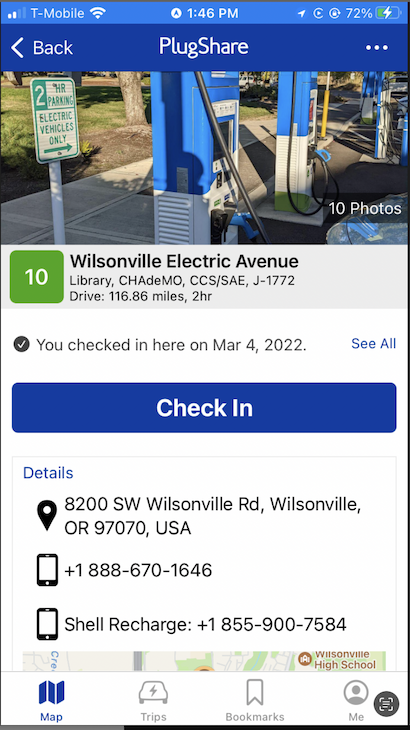
At Wilsonville, I chose to wait longer than the plan called for, charging for ~50 minutes up to over 80% while I walked around the park and had a snack.
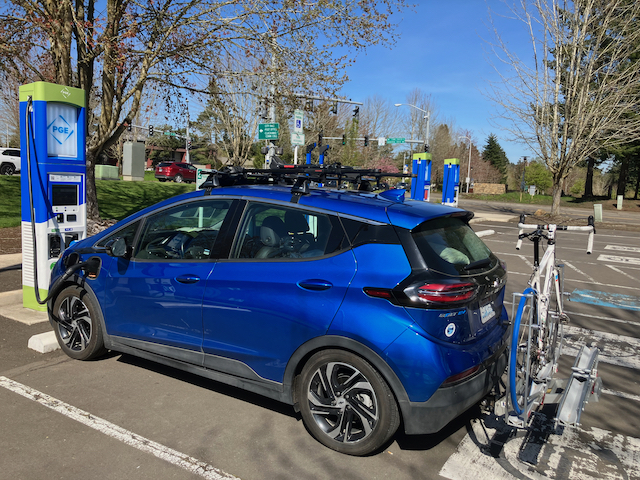
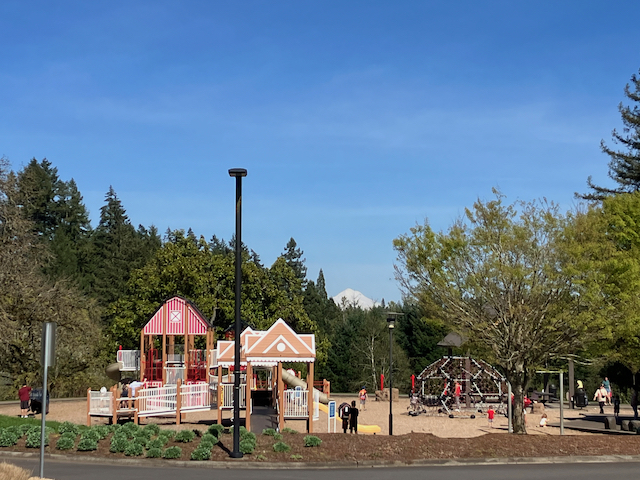
I then had A Better Route Planner remake the plan - it doesn’t seem to cope with being ‘off route’ and it doesn’t know how to pull live data (charge %) from the Bolt, so I had to put that in. It came up with a new plan, a quick stop in Springfield, OR.

A 15 minute stop in Springfield, in a Target parking lot (not every fast charger can be next to a park or a bakery). This charger was an Electrify America station, worked on the first try.
It’s possible this stop wouldn’t have been required if I had spent a bit more time in Wilsonville and had been willing to let the battery run lower, but I was playing it conservatively while I figured out my route.
Then I drove ~100 miles down to the campground in Canyonville, OR and set up camp. RV sites (where I can charge overnight) were available.
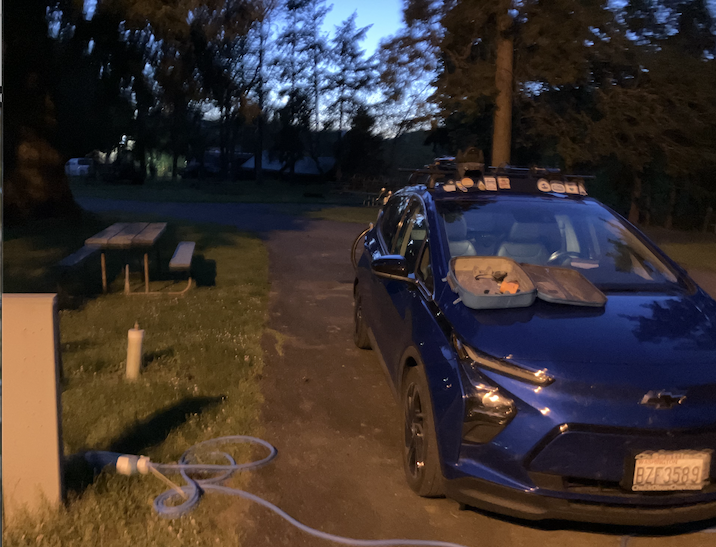
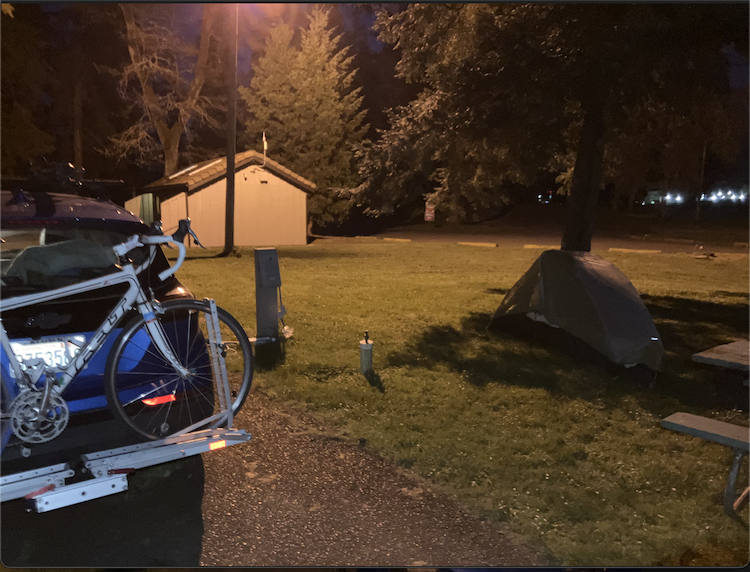
At the campground, I was able to plug in to an RV post; the post has a 30 A plug, unfortunately the standard for ’30 A’ plugs is 120v/30A, and the Bolt limits itself to 12 A on 120v (1.4 kW). A number of EVs have this limitation, though not Teslas.
This campground is a good-enough option, though it’s pretty close to I-5.
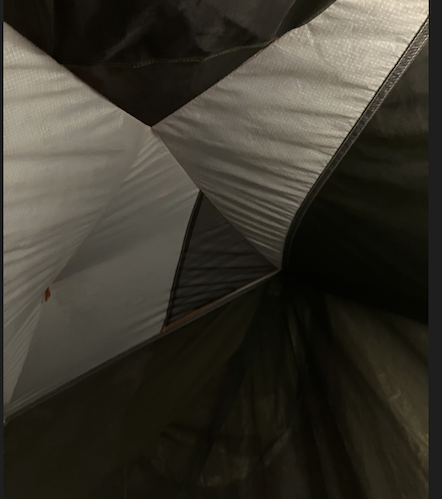
Good night! On to Grants Pass and California tomorrow
Underway on Electric Power, an EV Roadtrip liveblog
I'm going on an electric car road trip - Seattle to Bodega Bay, CA to help my ex- in the field at Bodega Marine Reserve; then Bodega Bay, CA to Dolores, CO to train for and ride the Iron Horse Bicycle Classic and to go to the Telluride Bluegrass Festival with family; then back to Seattle.
I'm driving a Chevy Bolt; the Bolt uses the "CCS" network of public chargers, like most non-Tesla electric cars. CCS and public charging have a mixed-reputation; electric roadtripping is still a "new" phenomena, especially with non-Teslas. My co-worker Liz Shelly prompted me to share my experiences - how I plan the trip, how / where I charge and camp, and what worked and what didn't!
I'll be liveblogging the trip; day 1, Tacoma, WA on to Oregon!